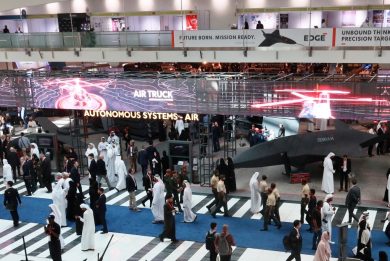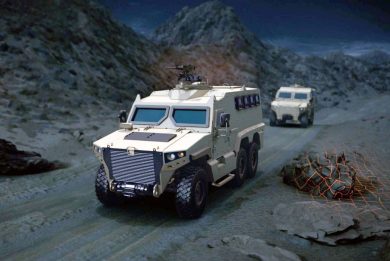IDEX 2025 – Anavia, part of the EDGE Group, unveils the HT-750 heavy lift unmanned helicopter
Following the success of its HT-100 VTOL UAV, Switzerland-based Anavia, which majority stake was acquired by EDGE in late 2023, unveiled its beefed-up helicopter-type unmanned system at IDEX 2025, the HT-750
Today the HT-100 has been sold to nine countries and operates in every continent. Following its success, the company decided to develop a bigger variant, with increased endurance and payload, while maintaining a lot of commonalities with the smaller airframe, such as the peculiar exoskeleton frame concept. This can accept three pods, the bigger one at the front and two smaller ones on the sides, which give total flexibility in terms of mission payload and fuel, allowing the customer to tailor endurance and sensors to the mission.
The HT-750, the number indicating the maximum payload capacity, has a conventional helicopter architecture, with a four-blade bearing-less main rotor with a diameter of 7.5 metres, and a two-blade tail rotor, the tail boom having a horizontal plane on top of the vertical stabiliser. The turbine provides 230 shp of continuous power, with 250 shp as take-off power; it is located on top of the fuselage, the exhaust being visible at the back of the turbine fairing. The HT-750 can reach a maximum speed of 222 km/h, and can withstand a maximum wind speed of 45 km/h.
Excluding rotors, the HT-750 is 6.88 metres long, 1.67 metres wide and 3.35 metres tall; the dry empty mass indicated at IDEX was 400 kg, such a reduced figure being obtained with the use of carbonfibre, glassfibre being used only where radiofrequency-transparent elements are needed, such as in the places where antennas are installed. The fix landing gear is part of the exoskeleton and keeps the fuselage high enough to allow for payloads to be mounted under the helicopter. With a take-off mass of 1,150 kg, this left a 750 kg payload including mission payload and fuel. In fact, most recent estimates bring the empty mass at 380 kg, thus increasing the estimated payload to 770 kg, although the name of the Anavia UAV should remain HT-750.
EDR On-Line understood that Anavia fully exploited the know how acquired with the HT-100 development, as well as some building blocks, to reduce development time and cost of its big brother. For risk mitigation purposes, Anavia carried out in parallel the airframe development and its certification process. To reduce costs and risks off-the-shelf components have been used as much as possible. The development process was carried out in full cooperation with other EDGE entities, following the one-EDGE philosophy.
The HT-750 leverages the autonomy bricks of the smaller aircraft; it can be flown either fully autonomous, also in take-off and landing, or in manual-assisted mode with a man-in-the loop handling a ground control station. A line-of-sight fully encrypted data link ensuring a data rate of 100 MBPS is installed and provides a range up to 200 km; a SATCOM system can be fitted to ensure limitless range. Beside the data link, the HT-750 is fitted with a GPS with anti-jamming protection, a Detect And Avoid System (DAAS), an Automatic Dependent Surveillance–Broadcast (ADS-B), a radar altimeter, and other sensors.
As said, the last figure available for the overall payload is 770 kg. The turbine specific consumption is 60 litres per hour, the 900 litres maximum fuel capacity of the HT-750 offering a 15-hour endurance; as 900 litres of JP-8 have a mass of around 720 kg, this leaves 50 kg for mission payload, plenty enough to carry an electro-optic gimbal and a maritime radar, considering how much miniaturisation allowed to SWAP those systems. Considering the JP-8 fuel, typically used in modern aviation, the estimated endurance versus mission payload varies according to the following table:

To fully exploit that flexibility modularity is a must. This is why Anavia developed a series of pods. Usually at least one of the side pods is used for fuel, but both can be fuel tanks, with only the front pod for payload.
At IDEX a two-seat pod was visible beside the HT-750, which was fitted with an opaque pod. EDR On-Lie understood that two-seat, four-seat, casualty evacuation (CASEVAC), cargo, ISTAR (Intelligence, Surveillance Target Acquisition, Reconnaissance), and other pods are part of the design, some of these with a frontal overhang to allow enough space, for example to host a litter in the CASEVAC pod. A pod with skyhook and 70 metres rope and net is available, as well as one capable to remotely drop supplies by parachute. Anavia is also considering producing cargo pods with an active cooling system, for example for blood transport, as well as armoured pods.
A front pod, half fuel, half payload was also mentioned during the discussion, while pods designed according to specific customers’ needs might definitely be developed. The 15-hour endurance is reached with all three pods of the fuel tank type. Pods are fitted with connectors, electric and physical, to allow a near plug-and play pod replacement in order to minimise time needed for reconfiguring the HT-750 for a different mission. The company proposes a series of optronic gimbal by US-based Edge Autonomy, Trakka Systems, L3Harris Wescam, Controp and other.
The HT-750 seen at IDEX was a 1:1 scale mock-up; the real airframe is currently being built, the airframe structure being produced in parallel with mechanical and electronic components. EDGE and Anavia aim at first flying the real HT-750 in Q1/26.
Photos by P. Valpolini








